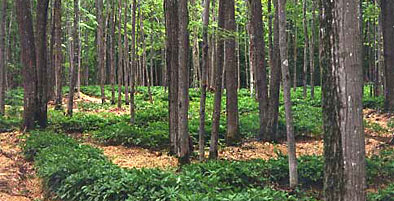The answer to the first question is, “yes,” but the key word is, “potentially.” As with any business venture, some risk is involved, and other considerations must be factored in before deciding if a business is worthwhile.
A primary consideration before beginning forest farming is the productive range of the medicinal plant. Plants, such as American ginseng (Panax quinquefolius) and goldenseal (Hydrastis canadensis), do not tend to grow well outside of their native ranges in the mountains and foothills. They would likely not perform well in the Coastal Plain region, for instance. However, other medicinal plants, such as witchhazel (Hamamelis virginiana), elderberry (Sambucus canadensis), wildginger (Asarum canadense), mayapple (Podophyllum peltatum), and bloodroot (Sanguinaria canadensis), may perform well, for example, in the Piedmont and Coastal Plain regions of the eastern United States.
Many other factors might influence how much money you can make by cultivating medicinal plants on your forestland. First, site conditions (soils, slope, and aspect, etc.) influence the yield and productivity of medicinal plants. Second, the plants must be properly managed. Third, markets and prices may change over time. Fourth, products can be infected, injured, or destroyed by plant or fungal diseases, animals (e.g., deer browse), or weather (e.g., drought or flooding). Finally, human beings themselves are a risk in terms of theft or poaching of valuable plants. Before investing in forest farming, it is recommended that a forest landowner write down a business plan that considers these factors.
In good circumstances, forest farming of medicinal plants can be quite lucrative. One example might be ginseng. Persons and Davis (2007) describe a system for “wild-simulated” American ginseng production on a half-acre forested plot of land that, by their estimate, would cost $7,540 in terms of labor, materials, and energy, and could yield an undiscounted revenue of $28,000 (80 pounds of roots at $350/lb) after nine years. This generates a net profit of $20,460 on a half acre over nine years, but does not include any discount for the risk involved, the (opportunity) cost of land, or the cost of capital in terms of the time it takes to produce the roots. If the price were to drop significantly, or if a poacher stole a large quantity, the profit could be substantially reduced. On the other hand, prices could be higher, generating an even better return.
Many other medicinal plants may have somewhat lower potential returns, but involve less risk. The website NCherb.org includes production guides with general information on production costs and prices of medicinal herbs, such as black cohosh (Actaea racemosa), bloodroot, echinacea (Echinacea angustifolia), and goldenseal.
References
Davis, J.M. 2012. NCherb.org website. NC State University. NCherb.org.
Persons, W.S. and J.M. Davis. 2007. Growing and Marketing Ginseng, Goldenseal, and Other Woodland Medicinals. Bright Mountain Books, Fairview, NC. 466 pages.
